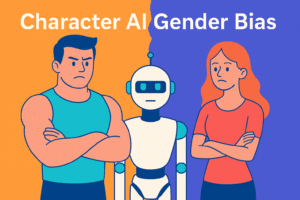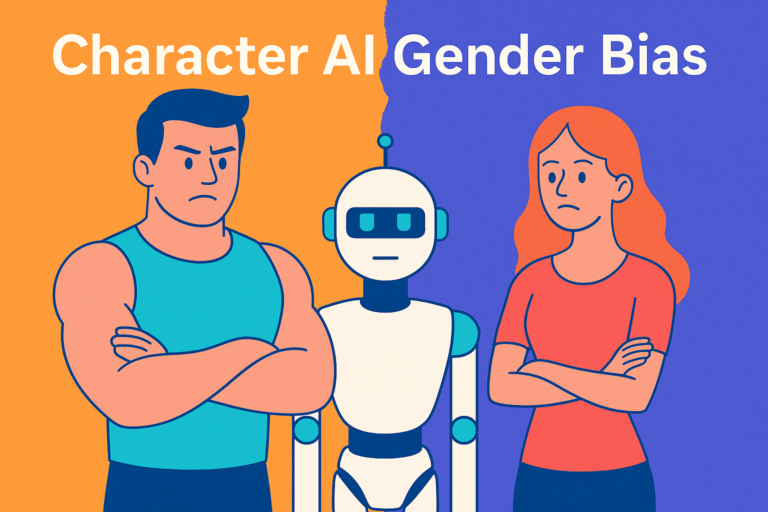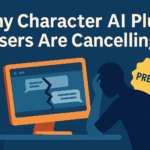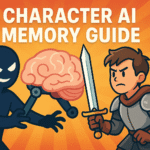You spend hours crafting your perfect persona— every detail deliberate, from height and build to temperament but due to Character AI gender bias, the second you start chatting, the bot throws your character into a generic stereotype.

Men become ripped bodybuilders or cocky flirts. Women get shoehorned into being frail, “feisty,” or unreasonably seductive. Non-binary personas? Often ignored entirely, misgendered, or reduced to a joke.
This isn’t just a quirk of the algorithm — it’s a deep-rooted pattern that frustrates casual users and serious roleplayers alike. And the worst part? It happens regardless of how clear your descriptions are.
What You Will Learn
- The three most common ways Character AI gender bias shows up — and why it keeps happening.
- How user experiences reveal consistent patterns in bot behavior.
- Why the memory and narrative engine are partially to blame.
- Practical workarounds to get more accurate roleplay experiences.
- Which alternative AI platforms handle personas with more nuance.
Core Takeaways
- Bias is baked into bot defaults — it’s not about you “writing it wrong.”
- Male personas often get defaulted to muscular, tall, and flirtatious — no matter the script.
- Female personas are repeatedly framed as fragile, feisty, or overly seductive.
- Non-binary and gender-diverse personas get misgendered or stereotyped almost immediately.
- Workarounds exist, but they require constant reinforcement and editing.
- For roleplay without persistent misrepresentation, alternatives like Candy AI handle diversity better.
Breaking Down the Three Major Bias Patterns
After combing through countless user experiences, the Character AI gender bias problem falls into three main categories. These patterns aren’t random — they’re baked into how the platform’s narrative AI interprets and defaults to certain stereotypes.
1. Male Personas: The Unwanted Bodybuilder Archetype
No matter what description you give, male characters often emerge as towering, muscular, and “effortlessly attractive.” Even if your persona is a quiet librarian, the bot might decide they can bench 1,500 lbs for no reason. The assumption? All men must fit a dominant, physically imposing mold.
“It’s like I specify that my character is short and not a bodybuilder, but then the AI just decides I’m ripped and can lift cars.”
Some users report their male personas automatically becoming flirty, even in strictly platonic or professional storylines. In other cases, soft or gentle male characters are infantilized — called “fragile” or “like a porcelain doll” — instead of being taken seriously.
2. Female Personas: Fragile, Feisty, and Overly Seductive
Female personas fare no better. The default lens tends to shrink them, strip away complexity, and over-sexualize interactions. Even a fully armored warrior can be reframed as “slender,” “delicate,” or “seductive” within minutes of conversation.
“Whenever my character stands her ground, the bot calls her stubborn or a ‘smart aleck.’ She’s not being sassy — she’s asserting boundaries.”
A particularly frustrating bias is the “feisty” label. Women expressing justified anger are reframed as playful or provocative, which derails serious roleplay. Worse, some bots ignore safety cues entirely, pushing scenarios users didn’t consent to.
3. Non-Binary and Gender-Diverse Personas: Erasure and Misgendering
For players using non-binary, genderfluid, or other gender-diverse personas, the AI often struggles to maintain consistency. Misgendering happens quickly, even when pronouns are explicitly stated. Some bots “choose” a gender at random after a few exchanges, while others switch back and forth mid-conversation.
“I start the chat with they/them pronouns, and within ten minutes the bot’s calling me ‘she’ or ‘he’ — and sometimes both in the same scene.”
The erasure is compounded when physical descriptions get overwritten with gender-coded clichés: short = woman, muscular = man, androgynous = “fragile.”
Comparison Table: How Gender Bias Manifests in Character AI
| Persona Type | Common AI Misinterpretations | Impact on Roleplay | Example |
|---|---|---|---|
| Male | Bodybuilder physique, flirty demeanor, infantilization of gentle traits | Breaks immersion, undermines non-physical storylines | “Your strong arms could lift me so easily…” despite no strength in description |
| Female | Shrinking height, “feisty” labeling, over-seduction | Undermines authority, sexualizes non-romantic scenarios | Warrior queen called “fragile” |
| Non-Binary | Random gender assignment, pronoun inconsistency | Identity erasure, loss of intended dynamics | They/them persona suddenly called “princess” |
Why the Bias Exists and How the Algorithm Reinforces It
Bias in Character AI isn’t just a cosmetic annoyance — it’s a byproduct of how the system was built. The problem starts with training data and is amplified by narrative defaults that the AI falls back on when it’s unsure.
1. Training Data That Overrepresents Stereotypes
Character AI’s language model is trained on vast swaths of internet text, fiction, and pop culture dialogue. Unfortunately, much of that data reflects outdated or exaggerated gender roles. In those sources, men are often portrayed as strong, tall, and stoic, while women are described as small, attractive, and emotionally reactive. Non-binary representation? Barely there — and often inaccurate.
When the bot doesn’t have strong persona-specific cues to follow, it leans into those overrepresented patterns. That’s why even meticulously crafted personas can get steamrolled by clichés.
2. Narrative Templates and Autocomplete “Filling Gaps”
Most roleplay bots work by predicting the most likely next sentence based on your input. If the model doesn’t have clear guidance, it defaults to what it “thinks” is standard. Unfortunately, “standard” for gender in its dataset often means stereotypes.
This explains why a male librarian might still get described as “towering over you,” or a female soldier gets called “fragile” in the middle of a battle scene. The AI isn’t intentionally disrespecting your description — it’s just filling in blanks with the easiest (and most overused) tropes.
3. Memory Decay and Context Loss
Even if your bot gets it right at the start, memory decay means it will eventually forget. After enough messages, earlier details fade from the active context, and the AI starts relying on default patterns again. This is why you might see perfect accuracy in the first 10 messages and then a sudden drift into stereotypes.
Some users try to combat this by “peppering in” reminders about height, build, pronouns, and personality every few replies. It helps — but it’s exhausting.
4. The Absence of Identity-Sensitive Roleplay Filters
Currently, Character AI doesn’t have robust identity-sensitivity filters that prevent stereotype drift. This means that when the model starts free-associating, nothing actively pushes it back toward respecting the player’s established identity markers. In practical terms, that’s why your 7-foot-tall non-binary warrior might suddenly get called “princess” halfway through a duel.
If you combine these factors — skewed training data, lazy narrative defaults, fading memory, and a lack of corrective filters — you end up with exactly the kind of Character AI gender bias users are reporting.
Workarounds and Fixes — How to Fight the Bias
While you can’t fully erase Character AI gender bias from the platform, you can reduce how often it intrudes on your roleplay. These strategies come directly from users who’ve tested dozens of scenarios and tweaked their approach until the bots behaved more consistently.
1. Pepper in Identity Reminders
Don’t assume the bot will “remember” after the intro. If you want your character’s build, height, pronouns, or other defining features to stick, reintroduce them naturally every 5–10 messages. This prevents memory decay from erasing important details.
Example:
Instead of “I walk into the room,” try “I walk into the room, my 5’10” frame casting a shadow across the desk.”
It’s repetitive, but it works.
2. Use Pinned Messages — But Keep Them Concise
Pinned messages can act like a mini character bible. Keep them between 500–600 characters to ensure the bot actually processes them. Overly long pins tend to get ignored. Include appearance, personality, and pronouns in plain language.
3. Edit the Bot’s Output in Real-Time
If the bot misgenders your character or invents a trait that contradicts your description, use the edit feature immediately. Over time, this can “teach” the bot to avoid repeating the same mistake in the current chat.
4. Design Your Own Bots for Better Control
Creating your own bots gives you more control over definitions and starting prompts. You can bake in your persona’s details from the start and enforce them in the training data. It’s extra work, but for many roleplayers, it’s worth it.
5. Consider Alternatives With Better Persona Handling
Some platforms have more consistent respect for character identity. For example, Candy AI allows for deeper memory settings and more accurate persona adherence in long-form roleplay. It’s not perfect, but many users report fewer misgendering and stereotype issues compared to Character AI.
Quick Reference Table: Bias Mitigation Tactics
| Tactic | Ease of Use | Effectiveness |
|---|---|---|
| Pepper in reminders | Easy | High |
| Concise pinned messages | Easy | Medium |
| Real-time editing | Medium | High |
| Create your own bots | Harder | Very High |
| Switch to alternatives | Easy | High (varies by platform) |
Conclusion + Final Thoughts
The frustration over Character AI gender bias isn’t about nitpicking minor roleplay quirks — it’s about the AI failing to respect user intent. Whether you’re writing an epic fantasy with a stoic male healer, a political thriller with a sharp-minded female diplomat, or a lighthearted slice-of-life with a non-binary barista, your vision shouldn’t be overwritten by lazy stereotypes.
Bias in AI roleplay isn’t always malicious — but it’s structural. It’s baked into the model’s training data, reinforced by default narrative shortcuts, and magnified by memory decay. And until Character AI implements better identity-sensitive systems, users will have to keep fighting for accuracy in their own stories.
If you’re committed to staying on the platform, the workarounds in this guide will help you get closer to the roleplay you want. If you’re open to exploring, alternatives like Candy AI and other platforms with more advanced memory handling can provide a more consistent experience.
The takeaway? You don’t have to accept misrepresentation as “just how AI works.” With the right strategies — and maybe the right tools — you can reclaim your characters’ identities and keep your stories intact.
User Quote Wall — Real Experiences With Character AI Gender Bias
“It’s like I specify that my character is short and not a bodybuilder, but then the AI just decides I’m ripped and can lift cars.”
“Whenever my character stands her ground, the bot calls her stubborn or a ‘smart aleck.’ She’s not being sassy — she’s asserting boundaries.”
“I start the chat with they/them pronouns, and within ten minutes the bot’s calling me ‘she’ or ‘he’ — and sometimes both in the same scene.”
“My persona is a curvy petite powerful Empress with an army… and the bot calls me a ‘thin little princess’ like I’m helpless.”
“I’ve had bots completely ignore the fact that my character is non-binary. They pick a gender for me and stick with it.”
“Even with tan skin in my description, the bot keeps calling my character pale. It’s like there’s only one default look in its head.”
“The bot thinks my 7-foot-tall warrior needs protecting — from a character half her size.”


